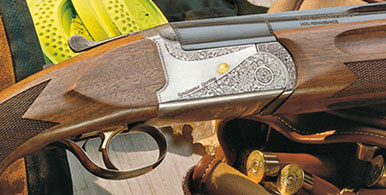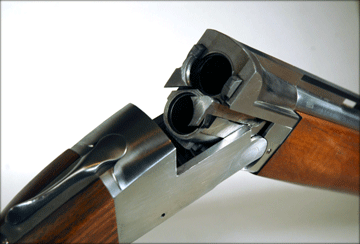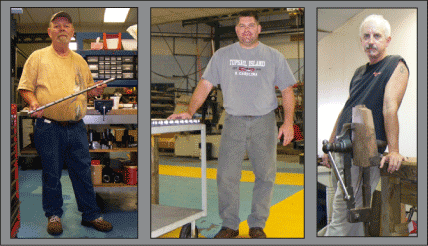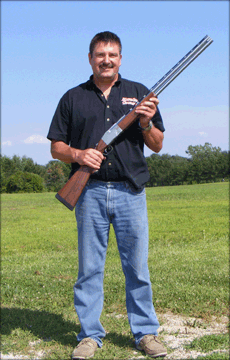
Shuck a pump gun and testosterone immediately triggers fireworks in the brain – even if the gun is specifically designed for women.
And that is exactly what happened when we shot the Ithaca Model 37 With Ladies Stock.

Shuck a pump gun and testosterone immediately triggers fireworks in the brain – even if the gun is specifically designed for women.
And that is exactly what happened when we shot the Ithaca Model 37 With Ladies Stock.
Most people call it the SHOT Show. We think of it as Shotgun Candyland.
The Shooting, Hunting, Outdoor Trade Show and Conference (SHOT Show) is the largest and most comprehensive trade show for all professionals involved with the shooting sports and hunting industries. You’ll find plenty of so-called black guns for the tactical market, state-of-the-art bows, ammunition, a boatload of pistols and just about every conceivable gadget and gear on the planet for the hunting and shooting enthusiast as well as tools of the trade for the police and military.
The SHOT Show is also the best possible place to find shotguns for wing and clays shooting all under one roof. The giants of the industry such as Beretta, Browning, Winchester and Remington set aside sections in their massive exhibits for over/unders, semi-autos and side by sides.
They are accompanied by smaller companies with devoted followings such as Blaser, Fausti, Zoli, Ithaca, Caesar Guerini, Connecticut Shotgun, Benelli, Franchi, Stoeger and others.
The SHOT Show kicks off every year with Media Day. This gives the firearms press the opportunity to shoot just about every type of gun at a range. We flew in a day before the show actually started to participate in Media Day, giving us the opportunity to evaluate some new shotguns and perennial favorites. In a moment, we’ll share our impressions with you of a day on the range with these shotguns.

This year’s SHOT Show returned to Las Vegas from Orlando, where it was held in 2009. The SHOT Show packed the Sands Expo & Convention Center from January 19th through the 22nd.
The shows’ sponsor and owner, the National Shooting Sports Foundation, said that overall attendance reached 58,444, approaching the all-time record of the 2008 Las Vegas Show and approximately 11,000 more than last year’s show in Orlando. The 1,804 media professionals in attendance also set a new high. Exhibiting companies numbered 1,633 across some 700,000 net square feet in the convention center’s halls and the Venetian Hotel’s meeting rooms.
Whether you were on the show floor, the press room or the Media Day shooting ranges, you could hear languages spoken from Europe and Asia. At the Desert Sportsman’s Club, a group of reporters in front of me started speaking in German before switching to French when a fellow writer joined them.
The Desert Sportsman’s Club in Las Vegas hosted the 2010 New Product Event. Among the gun makers participating, we focused on shotguns provided by Browning and Winchester. About eight stands were lined up with some seven trap machines in what turned out to be a shooting free-for-all.

Winchester’s Super X3 Flanigan Exhibition/Sporting semi-auto just begged to be shot. With its candy-apple red receiver and matching forend cap contrasted against the black Dura-Touch Armor Coating, the 12 gauge simply dazzled.
Exhibition shooter Patrick Flanigan has set some speed records with a modified X3 so expectations ran high for performance. The shotgun proved to be fast, but for some inexplicable reason Winchester literally cut corners on the trigger blade. The sharp, perpendicular edges hurt your trigger finger and made the gun unpleasant to shoot. It was a far cry from the Blaser F3 28 gauge we’re currently testing, which has perfect ergonomics.
At $1,479, the X3 Flanigan Exhibition is about one-quarter the price of the Blaser F3. Still, there’s no excuse to fit a shotgun with a trigger that cuts into your finger.
We also shot Winchester’s Super X Pump Black Shadow. The action on this one was very smooth, but once again the trigger edges were angular. In addition to the trigger being painful, it was stiff and heavy – far more so than the prototype Ithaca Model 37 Waterfowl Model we had shot just a few days before on a sea-duck hunt (we’ll give you the exclusive story on that shotgun shortly).
After the two Winchester shotguns we moved on to the Brownings.

We tried the Browning Maxus semi-auto. Introduced last year as the world’s most reliable shotgun, the two 12-gauge versions we shot both jammed on the second shot. One of them featured the Mossy Oak finish, while the other was black. We certainly would have expected more.
Next, we shot the Browning 12-gauge 625 Citori over/under. It delivered on Browning’s reputation for quality and value. The shotgun had low recoil and a good finish. The 625 felt solid, the way Brownings are supposed to, and the gun shot well.
We picked up a .410 version of the 625. It proved to be a stunning clays crusher. Weighing slightly over 7 pounds, it delivered the handling of a bigger bore shotgun with the sheer exhilaration you can only get from a .410.

Our favorite shotgun at the Desert Sportsman’s Club, however, turned out to be a 28-gauge Browning Cynergy Classic. From an aesthetics perspective, we always did like the angled lines of the Cynergy receiver where it meets the stock. Plus the Cynergy receiver has a much lower profile than the Citori. Overall, it’s a more elegant, modern looking shotgun. This 28-gauge was extremely accurate – allowing us to break the targets and many of the pieces. With a suggested retail price of $3,509, you would be hard-pressed to find a better 28 gauge for the money.
Next stop was the Boulder City Rifle and Pistol Range for Bass Pro Shops’ Media Day. Nearly every type of gun was available to the press, but we made a bee line to the shooting ranges of Blaser, Ithaca and Beretta.
Just for kicks, Blaser gave demonstrations of a muzzle loader, which broke targets with authority.
Beretta let us shoot a 12-gauge SV-10 Prevail. This handsome over/under benefits from state-of-the-art innovation that touches everything from the extractors to the hinges to the Kick Off anti-recoil on the butt of the stock. Once we located the point of impact and relaxed into the SV-10 Prevail, the gun proved nimble and easy to shoot, but we were disappointed in that it was difficult to crack open. These guns retail for about $3,000 and we can only assume opening the gun becomes easier over time. Otherwise, it would be a real challenge to buy a more advanced over/under at that price.

Also available to shoot was Beretta’s latest semi-auto, the A400 Xplor Unico, 12 gauge with the Kick Off recoil-reduction system. Officially unveiled at the SHOT Show, this gun is distinguished by the Unico chamber, which reliably accepts shells ranging in length from 2 ¾ to 3 ½ inches. The rotating bolt with reinforced lugs is flexible enough to manage the different shells while at the same time reduces time between cleanings and improving cycling time by some 30 percent. Weighing in at a scant 6½ pounds, it’s among the lightest semi-auto on the markets.
We found that we had to float the targets over the front bead to break the outgoers thrown from the single trap machine. The Kick Off worked as advertised, especially given the shotgun’s bantam weight. The A400 Xplor Unico shouldered fast and handled well. Priced at $1,725, it’s about $500 less than Beretta’s preceding flagship semi-auto, the 391 Technys Gold Sporting.
We wrapped up our Media Day shooting with the extraordinary Ithaca 12-gauge over/under Phoenix. The last time we shot it, the gun was in the prototype stage and we declared it the softest shooting 12-gauge over/under on the planet. Now several months later, the Phoenix was even tighter. The latest iteration of the gun shot so straight I’m convinced that even a blind folded shooter could crush targets with it. The Phoenix is in the final stages of refinement and we could see the first models come out of the factory this summer. If you’re interested, get your deposit in early because the Phoenix is already back-ordered.
Shotgun manufacturers took the opportunity to introduce several new models at the SHOT Show.

Franchi brought out a Renaissance Sport over/under in a 20-gauge. The coin-finished receiver includes ornate scroll work while the oil-finished stock is made of A Grade walnut. The suggested retail price is $2,349.
Winchester introduced the Walnut SX3 20 gauge at a starting price of $1,199. The All-Purpose Field model in 12 gauge is now available with a new Mossy Oak Break-Up Infinity Camo finish for $1,469.
CZ USA, the American arm of the Czech gun maker, brought out a new ultralight 12-gauge over/under called the Upland Ultralight. Its light alloy receiver brings down the weight to 6 pounds – 2 pounds lighter than the steel-frame versions. The new shotgun starts at $749.
Weatherby expanded its SA-08 line with two new models: the Deluxe and Waterfowler. The Deluxe features a high-gloss walnut stock and blued metalwork. It’s available in both 12- and 20-gauges models for $739. The Waterfowler has a camo synthetic stock and is only available in 12 gauge. It sells for $699.
We’re already looking forward to next year’s SHOT Show, to be held at the same venue on January 18-21. Stay tuned.
Irwin Greenstein is the Publisher of Shotgun Life. You can contact him at contact@shotgunlife.com.
Useful Resources
{loadposition signup}
There are no signs on the factory at 420 North Walpole Street in Upper Sandusky, Ohio, but open the old door and the pungent smell of machine oil is your first hint that the Ithaca shotgun is being re-born.
This rambling building that once housed a rolling rink, an automotive center and mold-making operation has been transformed into the backbone of the Ithaca Gun Company. Hard-working American men and women, like so many discarded in the upheaval of globalization, are now devoting their full measure of sweat and muscle to manufacture a new 100-percent American-built over/under shotgun code-named Phoenix.
“It’s nice to think that we could help our brothers and sisters in America by keeping and creating new jobs,” said Ithaca machinist, Tom Troiano.
Every screw, spring and steel billet is sourced from the U.S. as the company brings to life the stunning new 12-gauge Phoenix. From its inception, the Phoenix was designed to honor the proportions and sturdy sensibility of the classical over/under American shotgun.

Shotgun Life recently enjoyed the privilege of spending a full day at Ithaca talking with nearly everyone in the company. We spoke with the men who made the barrels, the receivers and the stocks. We spent time with management. And we were given the unique opportunity to be the first one outside of the company to shoot a prototype of the forthcoming Phoenix.
We can report unequivocally that design breakthroughs engineered into the Phoenix have made it the softest shooting 12-gauge over-under we have ever pulled a trigger on. The felt recoil on the Phoenix is virtually nonexistent – on par with the benchmark Beretta 391 Target Gold 12-gauge semi-auto – kicking only just enough to reset the inertia trigger.
Better yet, with a starting price of about $2,500 and moving to $10,000 depending on the type of engraving and grade of American walnut, the Phoenix could easily mark a renaissance of the big Ithaca shotguns.
That’s why Ithaca named the Phoenix after the dazzling mythical bird which rose from the ashes to fly once again. But leading Ithaca authority, Walt Snyder, author of the definitive books The Ithaca Company From the Beginning and Ithaca Featherlight Repeaters…The Best Gun Going observed that the new Phoenix also has an historical precedence.
In 1945, Ithaca had built a one-of-a-kind 12-gauge, over/under prototype. As the Model 51, it had serial number EX1, for experimental 1. It now appears that the new Phoenix is a direct descendant of that orphaned masterpiece.

Our first glimpse of the new 12-gauge over/under took place in January 2009 at the expansive Shot Show. There in booth 1736, I was drawn to the allure of an elegantly understated over/under that was all chrome-moly black steel and American walnut. The receiver, devoid of engraving, drew me in and I picked up the gun. I mounted it to my shoulder, my immediate impression one of a tight, well-balanced shotgun. Then I moved the top lever to the right and to my astonishment the barrels slowly fell open as though on hydraulics.
This was the shotgun that Walt would see several months later at a dealer event in Wilmington, North Carolina. Ithaca’s Mike Farrell arrived with it and Walt’s initial impression was that “It looked like a very well made gun. It seemed to mount and balance very well.”
At the time of the Shot Show, the gun remained months away from being in shooting condition and it hadn’t been christened the Phoenix. But after returning to the office, I would occasionally call Mike, the company’s number-two guy (no one at Ithaca has a job title), until he agreed to let me visit the company and actually try the shotgun.
For those of you familiar with Ithaca shotguns, it would be easy to dismiss the Phoenix as another heartfelt effort to salvage this fabled American manufacturer established in 1883.
Taking its namesake from the first factory in Ithaca, New York, the company’s fortunes in later years have been a tortured tale of missteps as one management team after another tried to reclaim the glory years that spanned the late 1800s until Pearl Harbor. That was a triumphant epoch when Ithaca manufactured shotguns such as the Flues side-by-side, the Knick trap gun, the 3½-inch Magnum 10 and the Model 37 pump based on a design by John Browning.
Beginning in the late 1960s, the company changed hands several times until it padlocked the doors in1986. The following year a new investor group took the helm until 1996, when entrepreneur Steven Lamboy acquired the assets and rights to make the Ithaca doubles. He turned out some beautiful shotguns in Italy bearing the Ithaca name but fell into bankruptcy in 2003. By 2004, the Federal government attached the company’s bank accounts for back taxes and a bitter lawsuit ensued in New York state between various stakeholders. In 2005, Ithaca’s assets were surrendered and the company liquidated.
That’s when Craig Marshall entered. Owner of MoldCraft in Upper Sandusky, he converted the family mold-making business into a new iteration of Ithaca. During the transition, the Marshalls assembled the flagship Model 37 pumps from existing inventory with every intention of restoring the marque’s luster. Unfortunately, the Marshalls eventually found themselves under-capitalized for the venture to the extent that they were forced to idle the factory for eight months between 2006 and 2007.
Finally, in June 2007 industrial glass magnate David Dlubak acquired the company’s assets and Ithaca name from the Marshalls. He started making fresh plant investments in the nondescript Upper Sandusky facility and brought back the team working on the Model 37.
As Dave explained to us in Ithaca’s distinctly blue-collar conference room, “We want to make a high-quality shotgun, at an affordable price, that will fit in the working man’s hands. The gun is going to be that guy’s pride and joy. The old Ithacas lasted fifty or sixty years. Now we make them to tighter tolerances and with better steel. We don’t want cheaper, we want better.”
Like many luminaries in the industry, Dave did not get his start making shotguns. Just as Harris John Holland began as a tobacconist, and Charles Parker a maker of spoons, curtains and locks, Dave comes from a family that owns and operates one of the largest industrial glass recycling businesses in the U.S., Dlubak Glass.
Dave was in the process of finalizing a new product called “bubble glass” that combined concrete and glass in faux log building material. Replete with grains and knots, bubble glass is resistant to fire and insects but soft enough for an ordinary drill bit. He was looking for a mold maker who could package the bubble-glass logs for affordable and dependable shipment.
He went to MoldCraft and met the Marshalls. Dave was presented with an opportunity to invest in Ithaca. Instead, he bought it.
Although a long-time aficionado of Ithaca shotguns, he acquired the company because of “the quality of the people and their ability.” These tool-and-die makers were the “elite of the elite,” he said.
For example, barrel-maker Roger Larrabee has been a tool-and-die machinist for 47 years. He trained Tom Troiano, who turns out the receivers.
“Roger trained a lot of the guys here,” Tom said.

As a self-described “control freak” with a passion for quality, it was paramount for Dave to build a team with the capabilities to “make all the parts here,” he said. “I’m interested in making it all under one roof.”
He characterizes the Ithaca Gun Company as being in “stage two,” meaning that it has resolved the manufacturing issues with its current popular pump guns: the accurate Deerslayer series, the rugged Model 37 Defense, and the sweethearts of the pump-gun community, the 28-gauge Model 37 and the Model 37 Featherlight and Ultralight.
These shotguns showcased the production capabilities of the company. They demonstrated the team’s ability to craft receivers from a billet of steel or aluminum, to do away with soldering or any other heat-inducing joining, and to machine one-piece barrels with integrated rib stanchions that eliminate any potential warpage from the run-of-the-mill rib soldering.
“Ithaca certainly seems to have manufacturing savvy,” Walt said. “I’ve seen their Model 37 and it’s beautiful and I would assume they would be successful with the new over/under.”
These accomplishments came from “spending many midnights sorting these things through,” Dave said. “We’re not in love with wood, we’re in love with steel.”
The company’s passion for steel is clear when you tour the factory floor. As raw Pittsburgh steel goes from the mill-turn lathes to to grinders to finishing machines to polishers there is an almost monastic sense of duty among the people making parts for the shotguns. All the tooling and fixturing was developed in-house. Custom software was written by the youngest guy on the crew for the tightest possible tolerances. The individual components are funneled into an assembly room where one person hand fits everything together into a single shotgun.
After the factory floor I spent time with Aaron Welch, Ithaca’s designer and engineer. Looking over his shoulder in the cramped office, he rotated the solid-block 3D models of the Phoenix on his computer monitor.
There was the Anson-Deeley boxlock action ready to fire 2¾ inch shells.
I discovered that a secret to the low recoil of the Phoenix are the three capsule-shaped pockets machined into the bottom of the receiver. They are designed to distribute the load of shooting, improve longevity of the components and help absorb the spent gasses. Moreover, the slightly greater mass of the receiver and monobloc combine to give the Phoenix a lower felt recoil. The less-restrictive 1.5 degree forcing cone and somewhat heavier burled stock also helped tame excessive kick.
In examining the monobloc, Aaron talked about how the barrels are held to the breech section by a tubular connector, instead of being soldered, to improve reliability. At the business end of the 30-inch barrels, the muzzles are dovetailed together, rather than soldered, to prevent distortion from thermal expansion.
That sense of a hydraulic assist when opening the shotgun comes from cocking rods that push against the hammer springs when you move the top lever.
The top bolting mechanism was borrowed from the old Ithaca Knick. It sits high in the receiver for a stronger grip on the monobloc.
Next I looked at how the rib slides into the stanchions and is mounted with a single screw. Aaron said that interchangeable ribs would be available to provide different points of impact.
In the end, the Phoenix would weigh about eight pounds.
Now it was time to see how all the parts worked together.

Mike grabbed the prototype of the 12-gauge Phoenix. The shotgun was still in-the-white with a couple thousand test rounds through it.
We drove a few minutes to a piece of property on a lake that had once been a quarry. A house overlooking it was under construction. The house belonged to Dave and was being built from bubble glass in cinder-block form factors.
In addition to the house and lake, the property also had a trap machine set up by the previous owners.
Mike handed me the gun and in fact it did feel very well balanced. I practiced mounting it a few times. The straight stock fit quite well. Dan Aubill, the guy in charge of Ithaca’s custom stock program, had told me that it was measured to fit the “average guy” with a 14¼ inch length of pull, zero cast, drop at comb of 1½ inch and drop at heel of 2¼ inch.
Pushing the top lever, the barrels slowly fell open. I loaded in two 1? ounce shells. Mike took up the controller and when I called “pull” two things immediately took me by surprise. The first was the extremely low recoil, the second is how I completely pulverized the targets.
Mike and I went through a couple of boxes of shells, the two of us taking turns pulling targets. The trigger was light and crisp, the beads lined up perfectly and the tapered forend enabled a wide range of control.
I turned out to be the last one who shot the Phoenix that day and when the time came to return it to Mike I thought “I gotta get one of these.”
Irwin Greenstein is the Publisher of Shotgun Life. Please send your comments to letters@shotgunlife.com.
Useful resources:
Join an elite group of readers who receive their FREE e-letter every week from Shotgun Life. These readers gain a competitive advantage from the valuable advice delivered directly to their inbox. You'll discover ways to improve your shooting, learn about the best new products and how to easily maintain your shotgun so it's always reliable. If you strive to be a better shooter, then our FREE e-letters are for you.
Shotgun Life is the first online magazine devoted to the great people who participate in the shotgun sports.
Our goal is to provide you with the best coverage in wing and clays shooting. That includes places to shoot, ways to improve your shooting and the latest new products. Everything you need to know about the shotgun sports is a mouse-click away.
Irwin Greenstein
Publisher
Shotgun Life
PO Box 6423
Thomasville, GA 31758
Phone: 229-236-1632